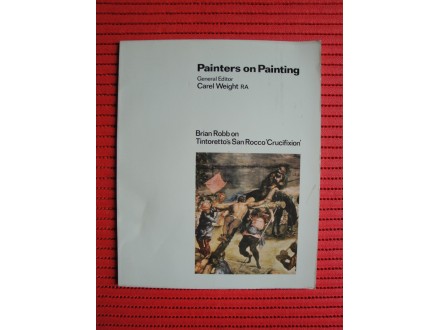Tintoretto`s Crucifixion
| Cena: |
| Želi ovaj predmet: | 2 |
| Stanje: | Polovan bez oštećenja |
| Garancija: | Ne |
| Isporuka: | Pošta Post Express Lično preuzimanje |
| Plaćanje: | Tekući račun (pre slanja)
Pouzećem Lično |
| Grad: |
Beograd-Čukarica, Beograd-Čukarica |
Godina izdanja: Ostalo
ISBN: Ostalo
Jezik: Engleski
Oblast: Slikarstvo
Autor: Strani
Painters on painting
Brian Robb on Tintoretto`s San Roco `Crucifixion`
London, 1969. godine na 32. strane + reprodukcija.
Knjiga je u odlicnom stanju.
Jacopo Comin (or Robusti), usually known as Tintoretto, was the immediate successor to Titian (1485-1576) as the leading light of Venetian painting during the second half of the 16th century. If Titian painted for princes and rulers the length and breadth of Europe, Tintoretto rarely left the city and specialized almost entirely in producing art for local patrons. But while limited geographically, Tintoretto was certainly not limited in his range of painting. As well as creating a number of innovative Venetian altarpieces, he dominated the local market for Venetian portrait painting (commissioned by local celebrities such as sea captains, soldiers, magistrates, and senators) and - along with Paolo Veronese (1528-88) - was the leading contributor to Venetian drawing of the time. All in all, it is fair to say that Tintoretto was the most original painter working in Venice in the later 16th century. Although Mannerism is a difficult term to apply to Venetian art, which did not experience the same transformations that took place in Florence and Rome, Tintoretto`s innovative and dynamic compositions, raking perspectives, shifts in scale, and Michelangelo-style figure painting are probably the closest that Venice gets to Mannerist painting, in spirit if not in content. Tintoretto`s ideal was to combine the drawing (or disegno) of Michelangelo with the colour (or colorito) of Titian - an ambition perfectly illustrated in the The Crucifixion. Deeply devout, Tintoretto spent a good deal of his life creating religious paintings for the Venetian scuole - the confraternities devoted to charitable works, which were also significant patrons of the arts (most of his works are still in situ in Venice).
Tintoretto`s greatest work is the huge and complex series of fifty canvases painted between 1565 and 1587 for the meeting rooms of the Scuola Grande di San Rocco (a confraternity devoted to combating the plague, a repeated scourge of the city.) A masterpiece of Biblical art, they illustrate scenes from the life of Christ and the Virgin in the upper and lower halls respectively, and scenes from the Passion - dominated by this huge Crucifixion - in the Sala dell` Albergo. The Crucifixion embodies a number of key characteristics of Tintoretto`s art. The teeming canvas, full of incident, also recalls several of Veronese`s monumental works - indeed, the sheer scale of the canvases sometimes used by these artists required a wealth of detail to fill the large area. The canvas of the Crucifixion took up an entire wall, and to help him create his intricate series of poses and compositions, Tintoretto made use of numerous small wax models which he moved around and illuminated from different angles.
In conception and execution, Tintoretto`s Christ on the cross is one of the most unusual and compelling scenes of the crucifixion of the 16th century. Instead of focusing on the individuals directly involved in the event, the artist provides us with a panoramic scene of Golgotha, populated by an astonishingly varied throng - including soldiers, executioners, horsemen, tradesmen, onlookers, thieves and apostles - engaged in all sorts of different activities and movements with almost insect-like urgency.
Ne saljem van Srbije.
Zbog visoke cene provizije post expresa predlazem da prethodno uplatite novac na ziro racun, dok cu vam knjigu poslati post expresom kome cete platiti samo postarinu.
Postoji mogucnost smanjenja postarine, ali samo ako znate broj vase dostavne poste, U tom slucaju knjigu preuzimate direktno u posti, pa je zato jeftinije.
Predmet: 40844635











